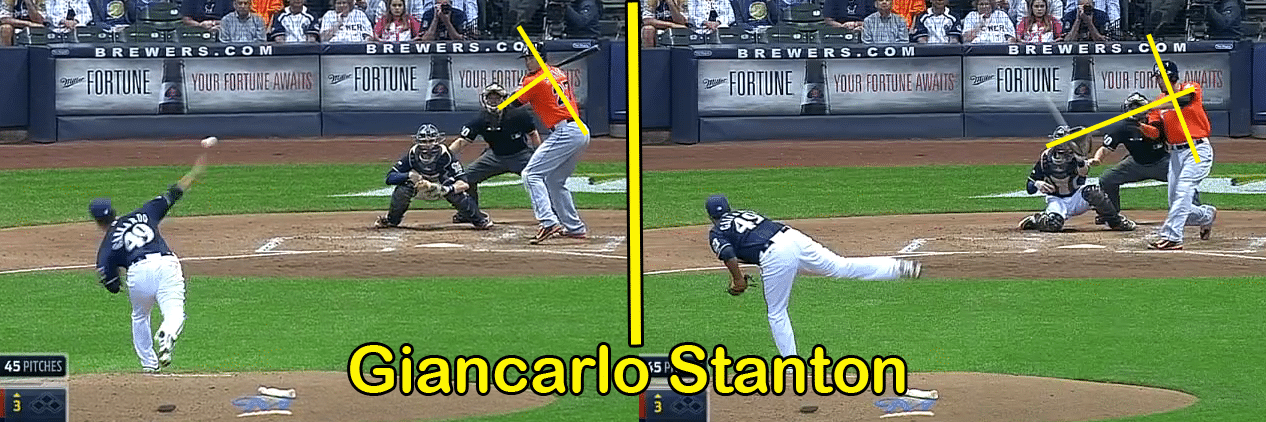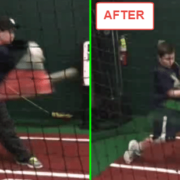Is Powerchalk The Best Video Analysis Coaching Software For Baseball & Softball?
Learn whether Powerchalk is the best video analysis coaching software for baseball and softball…
Can Video Analysis Software Cause You To Lose Out On Repeatable Power?
It may be how you’re using it…
The other day, I received a YouTube comment on my Adrian Gonzalez video:
“Ken Griffey Jr’s swing doesn’t display any handicap to the optimization of his angular momentum. His lead shoulder is pulled back leaving his hands quite close to his body.”
- Priorities: video analysis software v. human movement rules,
- What do a bucket, hanging object, and hitter’s front arm have in common, and
- The 90-degrees from the spine rule…
Priorities: Video Analysis Software v. Human Movement Rules
I used to be “that guy” who poured over slow motion swing footage using state of the art video analysis software. Slow motion analysis of hitters has become a peeing contest in hitting forums. You know the type…they’ve studied the video…they’ve worked with [fill in the blank name] professional hitter(s)…they coached 30+ years at a high level.
These “paper tiger” credentials don’t mean a thing to me now (and they shouldn’t to you, regardless of your experience in the game)…
I’ve been in corrective fitness for 10 years, and see a never-ending pattern of inefficient and flawed hitting mechanics. FOUR reasons why today’s hitters – YES, even the professional ones – are inefficient with their swings:
- Athletes are more sedentary nowadays,
- Hitting mechanics are often over-coached and micro-managed,
- A majority of instructors or coaches teach what I call “backward hitting strategies”, and
- Mechanical cues are general, misunderstood, and ineffective.
So who has the upper hand in today’s hitting forums, when it comes to video analysis software use? The person who understands human movement rules. One has to understand “the rules” first. As a result, this will cut slow motion video analysis time in half! This is seeing the forest before the trees.
Here’s an example of what I mean…
What Do a Bucket, Hanging Object, and Hitter’s Front Arm have in Common?

Giancarlo Stanton from the pitcher’s view…90-degree front elbow to spine at start and impact. Photo courtesy of MLB.com
We’re going to science for optimal placement of the front upper arm to set the plane of the pitch early, before the Final Turn. Here’s an email response I sent to one of my hitting friends, Bob Hall from Canada, about this very topic:
“Imagine a bucket with a large lip. Punch a hole in the lip and tie a string with a rock attached to the string at the bottom. Now, the level of the bucket lip is the shoulder angle. If you tip the bucket towards where the rock and string are attached, the rock will continue pointing “down”, and the space between the bucket and string will widen.”
Before the Final Turn, the efficient hitter will utilize a downhill shoulder angle (tipping the lip of the bucket). The elbow will continue to point down because of Gravity (the rock hanging from the lip), causing the light gap under the front armpit to widen. If the hitter artificially points the elbow up or down from this natural position, then muscles will activate making the hitter’s chances of getting on pitch-plane inefficient.
This is looking to human movement rules first. Now, let’s look under the hood using video analysis software…
The 90-Degrees from the Spine Rule
One of my readers, Kyle Harrington, posted this comment on the blog recently:
“One principle is that the bat only really accelerates efficiently when it is on a single plane. The only way to get maximum acceleration of the barrel is to have the swing path at 90 degrees to the spine angle. The only way to do this is to have the lead arm high and also 90 degrees to the spine. If the hands are too high or too low when both these other conditions are met, then the swing will be off plane.”
Using Powerchalk’s motion analysis software, we can see this pretty consistently with top hitters like Giancarlo Stanton. We can adjust to pitch height by bending at the waist, but the barrel should follow the 90-degree from the spine rule.
So, using motion analysis is good, but should take a “back seat” to understanding scientifically proven human movement rules.
- Fix Late Swings Fast: 2025 Pitch Recognition & See-Decide-Swing Training for Youth Baseball Power Hitters - October 6, 2025
- Safe Youth Weighted Bat Training: Proven Overload/Underload Drills to Increase Exit Velocity in Games Starting Tonight - September 29, 2025
- AI Coaching Course 2025: Youth Baseball & Softball Practice Plan + Off-Season & In-Season Workout Builder Fast - September 23, 2025









Great info Joey.
Thanks Bob 😀
I’ve been trying to learn more about hitting seriously for about 10 years. I have managed youth baseball (ages 6 to 18) for 15 years. What I have learned with HPL and Joey has been eye opening. In many ways what you are teaching reinforces so much of what others say, but you make it all make sense – through human movement. I have been planning our first indoor hitting practice for 2015 for our 12u team, and I realized that instead of 4 different drills (that probably do nothing) I can simplify so much and let the kids focus on what really matters. I have 3 things to focus on this season. That’s it. I feel like I’m cheating, but really it is honed focus that will pay off for the kids in great ways. The message of 90 degree front arm to spine is just another example of how simple this all can be.
On another note. If you can look into the spinal engine posts. Such a simple concept but so powerful. I personally have increased my lifts (dead and clean) just by focusing on keeping the spine in line.
Jeff, what an awesome compliment! I really appreciate that. When I set off to start HPL, there were a few things I wanted to do: 1) Expose true human movement rules, and 2) To distill down concepts that have been so difficult to decode and put them in simpler terms. I’m not perfect, but always learning from the experts (outside of baseball/softball) and my readers. I acknowledge the fact that I don’t know it all. I want the blog to empower others to do the same or exceed what I’m doing. Test, test, and test again. If you can show me the data, I’ll listen. If you’re going off of feelings, then I’m going to ask you to work harder for the answers. Because they’re there. We just have to look in the right places 😀
No … thank you Joey. You are indeed a very, very good hitting coach – and it’s a good thing too ’cause you aren’t going anywhere on looks!
Bob, so then all those “beast” comments I get, while my wife gets “beauty”, are correct? It’s my pleasure Bob. But it’s people like yourself that help us all to sharpen the blade 😉
The pursuit to help players improve their successes at the plate is rewarding. HPL and Joey’s principles are rewarding players and coaches. Is bat path really simple to 90* from spine angle and parallel with the shoulders? I just paused a rear view swing of Teddy #9 on the MLB channel, the body is moving the bat easy as that from the fight position. Faith and trust in you brother!!!
Great find Corey! Always test the stuff that I say or report. I’m not the end all be all. And I’m not the one with all the answers. There’s always someone who has a better understanding about this stuff than me. I totally get that, so test, test, and test again. Not every player will do it correctly on every pitch. You’ll find it consistently with “on-time” or close to on-time hitters. You may not on batted balls they may be off balance, out in front, or behind on.
I am finding that as I come back to view the videos again that I have missed something or it just becomes more clear. So it definitely helps to have this resource. Somehow I missed that the 90 degree angle was with respect to the front arm.
Clint, the 90-degree angle is the relationship between the barrel and spine, and not so much the front arm. Sometimes the front arm has to change shape to help in barreling the ball.